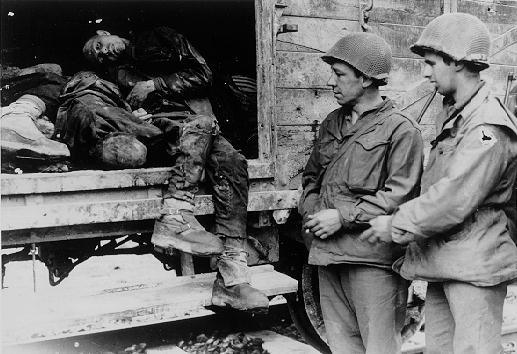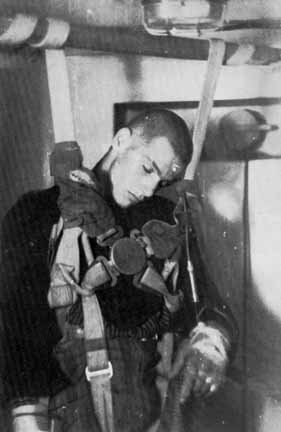A very interesting article about Dachau, written fairly recently, by Jeaneane Payne, can be read here on the online Knoxville Daily Sun. One surprising fact that I learned from this article is the information in this quote:
“Germans today prefer to use the term ‘death camps’ as opposed to concentration camps because the only purpose of the camps was to kill people in an industrialized way,” stated [the grandson of an SS man]. […]
[This young man’s] grandfather was a Nazi war criminal, an SS agent stationed at Dachau. As I was planning my trip to Germany to visit my daughter and son-in-law, [he] asked if he could travel to Dachau from Southwest Germany with us. […]
His grandfather was a volunteer in the SS. “He was proud of his involvement with the SS,” [his grandson] said. “He never showed remorse for his actions.”
After the war, the SS was declared to be a criminal organization by the Allies at the Nuremberg International Military Tribunal, so every man in the SS was a war criminal, regardless of his behavior during World War II. You can read about it on this website. The grandfather of this young man could have personally saved the lives of many Jews at Dachau, yet he would still have been a war criminal simply because he was in a military unit that had been declared (ex-post-facto) by the enemy to be a criminal organization.
This quote is from the article by Ms. Payne:
After touring the main facilities, we decided to go as a group to visit the crematorium knowing this would be the most difficult part for each of us, particularly for [the grandson of an SS man] who knew his grandfather had a part in the effort by the SS of placing so many innocent people in the ovens.
The crematorium had been built at the backside of the camp, out of view and out of hearing range of the screams of many thousands of people as they were being place[d] into the ovens. It was adjacent to the gas chamber which had been disguised as “showers”.

Cremation ovens at Dachau concentration camp

View of the inside of one of the Dachau ovens
Dr. Francizek Blaha was a prisoner, who worked at the Dachau crematorium, performing autopsies. The following quote is from the affidavit of Dr. Blaha, given to American interrogators on 3 May 1945, and presented at the Nuremberg International Military Tribunal in November 1945:
Sometimes prisoners were killed only because they had dysentery or vomited and gave the nurses too much trouble. Mental patients were liquidated by being led to the gas chamber and injected there or shot. Shooting was a common method of execution. Prisoners could be shot just outside the crematorium and carried in. I have seen people pushed into the ovens while they were still breathing and making sounds, although if they were too much alive they were usually hit on the head first.
Could this be the origin of the claim that prisoners were burned alive in the ovens at Dachau? Are tour guides now telling visitors that people were burned alive at Dachau?
According to Marcus J. Smith, a U.S. Army doctor, who wrote a book called The Harrowing of Hell about the days immediately following the liberation of the camp, the ovens at Dachau were used by the American military to cremate the bodies found in the camp, including the bodies of some of the Waffen-SS soldiers who were killed when the camp was liberated.
Smith wrote that, around May 6, 1945, the disposal of the bodies in the camp began:
It is time to dispose of the bodies. Some are carried to the gravel pits. Then the furnaces of the crematorium are stoked and reignited. By increasing the work day for the operators from four to ten hours, 710 corpses are cremated in the next four days. Too slow! A top-level decision is made to bury the dead.

Dachau prisoners who loaded the dead bodies into the ovens pose for a photo
The old photo above show crematory workers demonstrating how they dragged the dead bodies out of the morgue, loaded them onto a stretcher and then shoved them into the cremation ovens. Posed photographs, such as the photo shown above, were offered for sale to American soldiers who visited the museum set up in Baracke X by the US Army after the liberation of Dachau.
According to Marcus J. Smith, the chief of the Dachau crematorium crew was Ludvik “a heavy, powerfully muscled Czech who has labored in the crematorium for a long time.” Smith wrote that Ludvik sent him a letter in which he complained that his team of 10 people were not being treated as well as they had been by the SS. Ludvik wrote in this letter: “We feel that after our liberation, at least the same standard of living should be maintained. But our position is worse than then as to food, drinks and tobacco.”
Could it be that Ludvik and his fellow prisoners shoved Jews into the ovens alive? Or did the SS men come into the crematorium at night and burn a few Jews alive, just for fun? Is this why the SS was declared to be a criminal organization by the Allies ex post facto (after the fact)? The grandsons of the SS men should not be tortured by being told that SS men burned people alive in the ovens at Dachau. For shame!
Smith wrote that, because the cremation efforts were too slow, the bodies were buried by German civilians “at the American commander’s request.” The corpses were taken on carts to the burial site on a hill called Leitenberg where the bodies were transferred to a bulldozed excavation, according to Smith. He wrote that “Eventually 2,400 bodies were buried.” That would mean that there was a total of 3,110 bodies in the camp, including those of the prisoners who died between April 29th and May 6th after the liberation. There were allegedly 2,310 bodies on the death train that arrived in the camp on April 27, 1945, which would have to be included in this total. There were 2,226 prisoners who died in the month of May 1945 after the liberation of the camp; they were buried in a cemetery in the town of Dachau.

Photo of the body of Louis Schloss, who died at Dachau
Ms. Payne shows a photo of Louis Schloss, a prisoner who died after being punished at Dachau with this caption under the photo:
Nurembourg (sic) businessman Louis Schloss died on May 16, 1933 at Dachau as a result of a beating. To give the incident the appearance of a suicide, he was hung on a hook with suspenders. The above image was taken on May 17, 1933 under the direction of the State Prosecution Office.
It is true that Louis Schloss died in the Dachau camp after being beaten. Here is what happened: When the Dachau camp was first opened on March 22, 1933, the guards were police officers with the Munich police, but after only a few weeks, SS soldiers were assigned to guard duty in the camp.
The first Commandant of Dachau was SS Standartenführer Hilmar Wäckerle, who began using that title on April 19, 1933. Wäckerle was instructed by Heinrich Himmler, the head of the SS and the acting Police Chief of Munich, to draw up a set of rules for discipline in the camp. His rules were extremely harsh and a number of prisoners died after being punished.
The deaths in the Dachau camp came to the attention of the Munich prosecutor after Sophie Handschuch made a formal complaint in 1933, demanding to know the true cause of death of her son who had been an inmate at Dachau. Other prisoners who died in the early days of the camp were Dr. Rudolf Benario, Fritz Dressel, Sepp Götz, Ernst Goldmann, Arthur Kahn, and Erwin Kahn. Karl Lehrburger and Wilhelm Aron, both Jewish, also died as a result of harsh treatment in the Dachau camp. Herbert Hunglinge committed suicide to escape the unbearable conditions in the camp.
After an investigation by the Munich police, Wäckerle was charged with murder for the deaths of Louis Schloss on May 16, Leonard Hausmann on May 17, Dr. Alfred Strauss on May 24 and Sebastian Nefzger on May 25. Dr. Strauss and Louis Schloss were both Jewish. Because of the criminal charges, Himmler was forced to relieve Wäckerle of his command, as of June 25, 1933. The charges against Wäckerle were later dropped, but he was dismissed from his job as Commandant and sent to fight on the Eastern front, where he was killed in action. Wäckerle was replaced by Theodor Eicke who became the new Commandant. Eicke was also killed in action after he was transferred to the Eastern front.
In June 1934, Eicke was given the title of Inspector General and the authority to approve all punishments in all the camps.
The following quote is from the article written by Ms. Payne:
Pole hanging was a method of torture used in interrogation as well as punishment. Victims were hung up by their wrists, swung back and forth, and beaten.
“These are the torments of hell! The whole body weight hangs from the arms that are twisted backward. And the monsters stand in front of you and laugh at your pain, ask you whether you now want to confess, slap you in the face and pull and tug at your body. When you stay silent they swing you, often they whip you at the same time.” — “The Powerful and the Helpless,” prisoner account of Edgar Kupfer-Koberwitz (1940-1945 in the Dachau concentration camp) on pole hanging, 1957 (excerpt).

Fake photo of “tree hanging” is a still shot from a documentary made by the Soviet Union
Pole hanging was also called “tree hanging.” I previously blogged about pole hanging here. The photo shown above was taken in the second Dachau Museum, which first opened in 1965. When the Museum was expanded in 2003, this photo was removed. Although it was known that this was a fake photo, it was left up in the Dachau Museum for several years.
This quote is also from the article by Ms. Payne, which shows a photo of a door into a prison cell in the Dachau bunker:
During the 5 hours we spent at Dachau, the most difficult for me was viewing the prison cells. The walk down a long corridor portrayed each cell as being more deplorable than that the last.
Apparently, Ms. Payne was not told that the bunker had private cells for the privileged prisoners who were allowed to walk around around outside their cells and even to receive visitors. There was one wing of the bunker, that has since been torn down, which housed the SS men who had broken the rules. The night before the Dachau camp was liberated, 128 SS men were released from their prison cells in the bunker and ordered to man the guard towers, while the regular SS guards left that night.
After Dachau was liberated, it was turned into “War Crimes Enclosure No. 1 for German war criminals”. The cells in the bunker were used to incarcerate high ranking German prisoners. The Germans didn’t get a private cell; 5 men were placed in each cell where there was only one bed. They had to take turns standing, sitting and sleeping.
Ms. Payne shows a photo of one of the disinfection cells with the caption “Gas chamber.” At least, she got that right. A disinfection cell at Dachau was called a Gaskammer or “gas chamber” in English.

Photo of disinfection cell with the caption “Gas chamber”





























